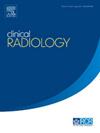宫颈腺癌患者术后预后风险分层:综合生物标志物的开发和验证
IF 1.9
3区 医学
Q2 RADIOLOGY, NUCLEAR MEDICINE & MEDICAL IMAGING
引用次数: 0
摘要
目前,缺乏对宫颈腺癌(CAC)的预后评估工具。为了开发手术后CAC患者的预后工具,我们创新地整合了对比增强计算机断层扫描(CECT)图像、临床病理变量和DNA甲基化数据的放射学特征。材料与方法回顾性收集CAC患者的临床及影像学资料。使用支持向量机分类器构建了前、后和融合放射学模型。结合临床、放射学特征和DNA甲基化数据来开发联合模型。采用Harrell' concordance index (C-index)评估模型预测无进展生存期的性能。Kaplan-Meier曲线用于显示模型分层的高危组和低危组之间的生存差异。结果共127例CAC患者(训练队列,n=86;纳入验证队列(n=41)。在验证队列中,基于放化疗和侵袭深度的临床模型的c指数为0.811 (95%CI: 0.784-0.838)。对比前、对比后和融合放射学模型的c指数分别为0.745 (95%CI: 0.688-0.802)、0.723 (95%CI: 0.668-0.778)、0.757 (95%CI: 0.708-0.806)。基于放化疗、ZNF582和造影后放射学特征的联合模型c -指数最高,为0.872 (95%CI: 0.835-0.909)。Kaplan-Meier曲线显示,高危患者的PFS明显短于低危患者(p < 0.05)。结论联合模型可作为CAC患者的预后分层工具,便于疾病监测和临床决策。本文章由计算机程序翻译,如有差异,请以英文原文为准。
Prognosis risk stratification in patients with cervical adenocarcinoma after surgery: Development and validation of integrated biomarkers
Aims
Currently, there is a lack of prognostic assessment tools for cervical adenocarcinoma (CAC). To develop a prognostic tool for patients with CAC after surgery, we innovatively integrated radiomic features from contrast-enhanced computed tomography (CECT) images, clinicopathologic variables, and DNA methylation data.
Materials and Methods
We retrospectively collected the clinical and imaging data of patients with CAC. Pre-, post-, and fusion radiomic models were constructed using a support-vector-machine classifier. Clinical, radiomic features, and DNA methylation data were integrated to develop the combined model. Model performance for the prediction of progression-free survival was evaluated using Harrell' concordance index (C-index). Kaplan-Meier curves were used to show the survival difference between high- and low-risk groups stratified by the models.
Results
A total of 127 CAC patients (training cohort, n=86; validation cohort, n=41) were included. In the validation cohort, the clinical model based on chemoradiotherapy and invasion depth achieved a C-index of 0.811 (95%CI: 0.784–0.838). The pre-contrast, post-contrast, and fusion radiomic models yielded a C-index of 0.745 (95%CI: 0.688–0.802), 0.723 (95%CI: 0.668–0.778), 0.757 (95%CI: 0.708–0.806), respectively. The combined model based on chemoradiotherapy, ZNF582, and post-contrast radiomic features obtained the highest C-index of 0.872 (95%CI: 0.835–0.909). The Kaplan-Meier curves display that the high-risk patients had significantly shorter PFS compared to the low-risk patients (all P<0.05).
Conclusions
The combined model can be used as a prognosis stratification tool for patients with CAC, which can facilitate disease monitoring and clinical decision-making.
求助全文
通过发布文献求助,成功后即可免费获取论文全文。
去求助
来源期刊

Clinical radiology
医学-核医学
CiteScore
4.70
自引率
3.80%
发文量
528
审稿时长
76 days
期刊介绍:
Clinical Radiology is published by Elsevier on behalf of The Royal College of Radiologists. Clinical Radiology is an International Journal bringing you original research, editorials and review articles on all aspects of diagnostic imaging, including:
• Computed tomography
• Magnetic resonance imaging
• Ultrasonography
• Digital radiology
• Interventional radiology
• Radiography
• Nuclear medicine
Papers on radiological protection, quality assurance, audit in radiology and matters relating to radiological training and education are also included. In addition, each issue contains correspondence, book reviews and notices of forthcoming events.
 求助内容:
求助内容: 应助结果提醒方式:
应助结果提醒方式:


